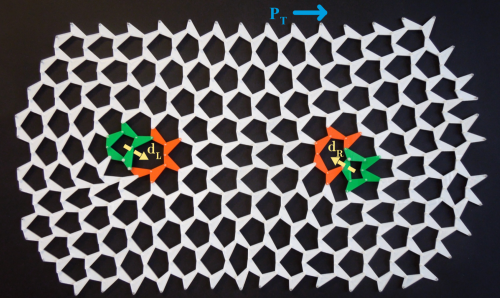Topological protection in mechanical metamaterials

Researchers at Leiden University, the Netherlands, showed that certain crystal defects in mechanical metamaterials can harbour topologically protected motions. These mechanical states are analogues of protected electronic states in quantum materials such as topological insulators. When actuated, such protected mechanisms could serve as the building blocks of robots. The research paves the way towards engineering nano-mechanical structures for robust information storage and read-out.
The authors of the study, Jayson Paulose, Bryan Gin-ge Chen and Vincenzo Vitelli, built a prototype of a so-called kagome lattice, named after a well-known Japanese pattern on woven bamboo baskets. In the pattern, hexagons are alternated with triangles. The prototype was made in the lab, and consists of triangles connected by hinges on all three corners. By rearranging the connections in the lattice, the researchers created defects that subtly disrupted the ordered pattern, but did not change the number of connections at any triangle. Two types of defects were realized – one that gave rise to a localized free motion, and one that locally enhanced the rigidity of the lattice.
The underlying mathematical theory was tested with computer simulations, both on a deformed kagome lattice and on a distorted square lattice with comparable defects. By controlling the location and the behaviour of these of topologically protected mechanical motions, the researchers see possibilities for the development of mechanical nano-structures that can be used for molecular robots. The research could also be used for robust information storage. Bits could then be represented by the presence (+) or absence (-) of a protected topological motion at a defect.
The research was done in the Topological Mechanics Lab (Leiden), founded by Vincenzo Vitelli. The lab is part of a new research program that aims to study both theoretically and experimentally the mechanical analogues of topological quantum materials.
The research was funded by FOM and Delta ITP (NOW & OCW).
More information: Topological modes bound to dislocations in mechanical metamaterials, Jayson Paulose, Bryan Gin-ge Chen and Vincenzo Vitelli, Nature Physics, 19 Januari 2015 DOI: 10.1038/nphys3185
Journal information: Nature Physics
Provided by Fundamental Research on Matter (FOM)



















